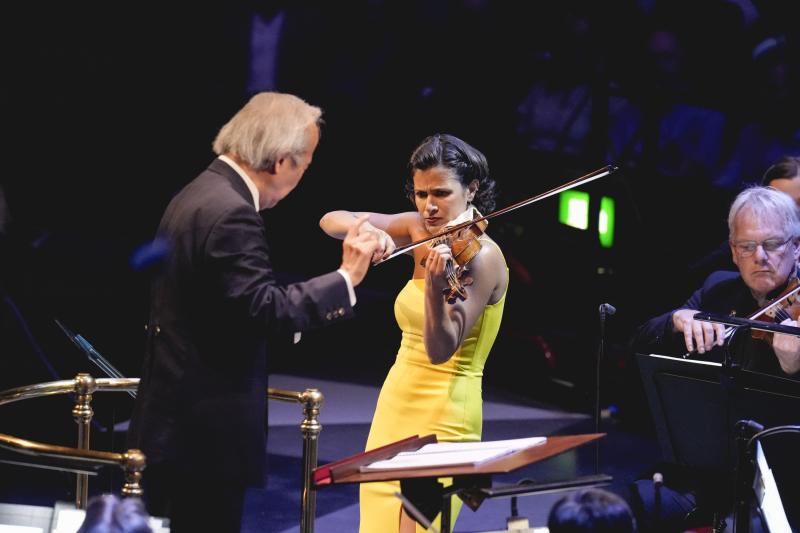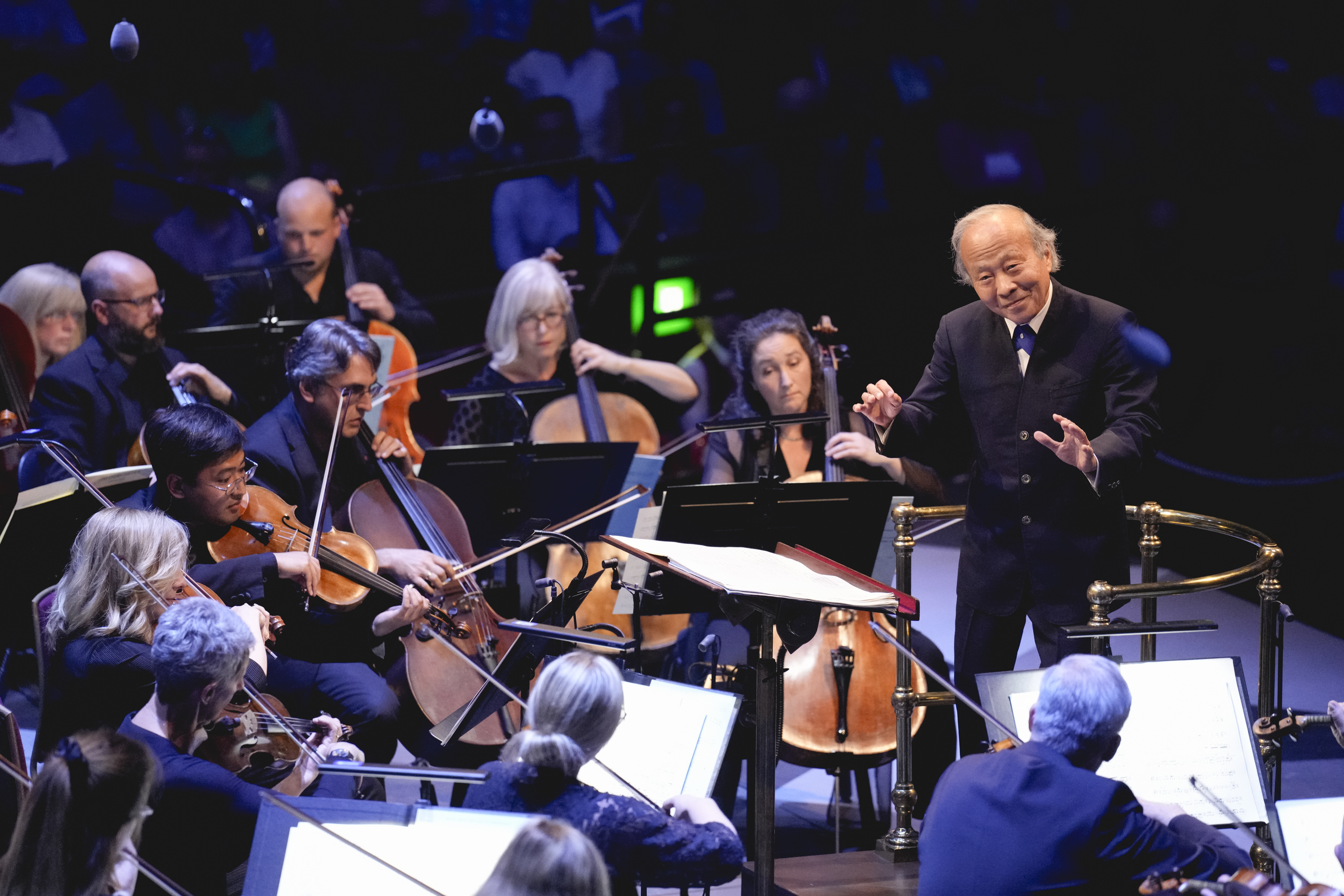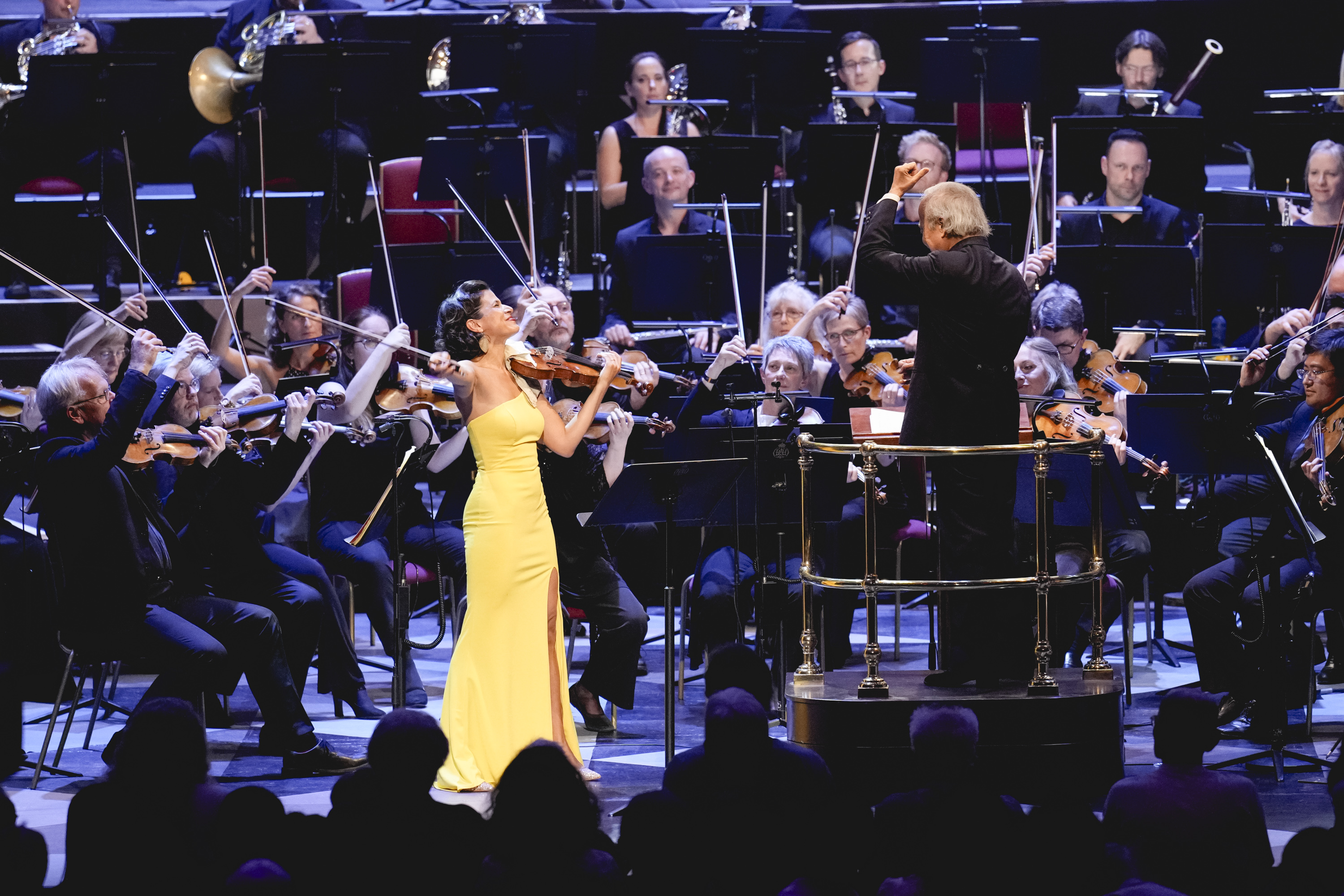Prom 7: Urioste, BBC National Orchestra of Wales, Otaka review – old friends, new worlds | reviews, news & interviews
Prom 7: Urioste, BBC National Orchestra of Wales, Otaka review – old friends, new worlds
Prom 7: Urioste, BBC National Orchestra of Wales, Otaka review – old friends, new worlds
Bittersweet Coleridge-Taylor, full-cream Rachmaninov – and a palate-cleansing Fifth

A full house, and television cameras: rarer events at the Proms than they used to be (or should be). Both lent a sense of occasion to the BBC National Orchestra of Wales’s visit to the Royal Albert Hall with their Conductor Laureate, Tadaaki Otaka. The cameras (for a BBC Four broadcast on Friday) had descended not for Cardiff’s long-serving Japanese stalwart – who first led BBC NOW in 1987 – but for Elena Urioste’s performance of the Violin Concerto by Samuel Coleridge-Taylor.
 Rachmaninov’s Études-Tableaux began life on the keyboard in the 1910s but, in 1930, a selection of five got the full orchestral works, courtesy of Ottorino Respighi. His typically spectacular, atmospheric, highly coloured orchestration brings a strong programmatic flavour to pieces that, on the piano, had told their own more inscrutable story. La mer et les mouettes paints rocking, swelling sea pictures on rippling low strings and via moody marine brass that almost made you taste the salt. Delius loomed in the offing. La Foire swung into a carnival-time stomp with some almost-Hollywood gloss and sheen while, in the Marche Funèbre, gathering menace climaxes in exultant Rachmaninov-branded bells. That said, Otaka’s array of shades also reminded me that, a few years earlier, Ravel had worked his own magic on Mussorgsky’s Pictures at an Exhibition: that gallery of divergent moods and textures surely finds echoes here. The fairy-tale of Le chaperon rouge et le loup (Little Red Riding Hood) took us deeper into the Russian folkloric woods as Otaka led a scary, breakneck gallop with some spine-chilling predatory brass, while the robust, jaunty Marche that winds up the set edged closer to Prokofiev's terrain. Otaka (pictured above) made the entire sequence a showcase for the instrumental palette of his players: rich, for sure, but graceful and clean-lined rather than overwhelmingly lavish.
Rachmaninov’s Études-Tableaux began life on the keyboard in the 1910s but, in 1930, a selection of five got the full orchestral works, courtesy of Ottorino Respighi. His typically spectacular, atmospheric, highly coloured orchestration brings a strong programmatic flavour to pieces that, on the piano, had told their own more inscrutable story. La mer et les mouettes paints rocking, swelling sea pictures on rippling low strings and via moody marine brass that almost made you taste the salt. Delius loomed in the offing. La Foire swung into a carnival-time stomp with some almost-Hollywood gloss and sheen while, in the Marche Funèbre, gathering menace climaxes in exultant Rachmaninov-branded bells. That said, Otaka’s array of shades also reminded me that, a few years earlier, Ravel had worked his own magic on Mussorgsky’s Pictures at an Exhibition: that gallery of divergent moods and textures surely finds echoes here. The fairy-tale of Le chaperon rouge et le loup (Little Red Riding Hood) took us deeper into the Russian folkloric woods as Otaka led a scary, breakneck gallop with some spine-chilling predatory brass, while the robust, jaunty Marche that winds up the set edged closer to Prokofiev's terrain. Otaka (pictured above) made the entire sequence a showcase for the instrumental palette of his players: rich, for sure, but graceful and clean-lined rather than overwhelmingly lavish.
 In sunburst yellow, Elena Urioste (pictured above) made a thoroughly engaging case for the Coleridge-Taylor concerto, her airy, silvery tone and fine filigree detail well matched to its melodic invention and elegant reveries. Coleridge-Taylor wrote it for American violinist Maud Powell, one of his champions, and originally planned a piece rooted in African-American spirituals. Something of that conception survives in the bittersweet harmonies of the memorable theme that drives the Maestoso first movement. But overall, the style feels nearer to the ecumenical song-like lyricism of Dvořák’s American phase: vernacular in its shadings, yes, but not culturally specific. No matter: Urioste’s ravishing cantabile touch made the most of a dominant solo part while the orchestral accompaniment very much plays second fiddle.
In sunburst yellow, Elena Urioste (pictured above) made a thoroughly engaging case for the Coleridge-Taylor concerto, her airy, silvery tone and fine filigree detail well matched to its melodic invention and elegant reveries. Coleridge-Taylor wrote it for American violinist Maud Powell, one of his champions, and originally planned a piece rooted in African-American spirituals. Something of that conception survives in the bittersweet harmonies of the memorable theme that drives the Maestoso first movement. But overall, the style feels nearer to the ecumenical song-like lyricism of Dvořák’s American phase: vernacular in its shadings, yes, but not culturally specific. No matter: Urioste’s ravishing cantabile touch made the most of a dominant solo part while the orchestral accompaniment very much plays second fiddle.
Indeed, the lovely middle movement, a nocturne-like andante semplice, takes us far along the road to the romance or rhapsody rather than concerto proper: hardly a problem, when the results delight. Otaka, who has excelled in Elgar and Glazunov as well as Dvořák, discreetly caught the yearning, gently melancholy spirit of the piece. The rondo-like finale saw orchestral textures thicken as Coleridge-Taylor crafts variations on a bustling dance, while Otaka gave Uristo’s soaring passagework the space to shine. The tension here between Coleridge-Taylor’s gift for fine-spun salon prettiness and an earthier, deeper, rhythmically complex idiom hints at how he might have developed had he lived. Urioste’s encore fed us a pure sugar rush: Harold Arlen’s “Over the Rainbow”, arranged by Tom Poster, in partnership with the NOW leader, Nick Whiting and his string principals.
As for the Fifth: what can one say? First, that Otaka cleverly deploys the strengths of his mid-size band: agility, flexibility, an energising push and pulse, and well-marked contrasts of tempi and dynamics. This was no torrential wall of sound but a lucid, bold, illuminated mosaic in which Beethoven's astonishing sonic and harmonic coups across the orchestral spectrum – from piccolo to basses – shone bright and clear. Sometimes (albeit with conventional forces) it even had a period-performance vibe. The Allegro con brio felt fleet-footed, dance-driven, almost Mozartian, light on the “fateful” doom and gloom. The disruptive oboe solo (Steven Hudson) jolted just as it should. As for the ensuing lilt and swing of violas and cellos, they really made you hear that the Andante con moto means just that: and Otaka never lost his moto. Here, as elsewhere, he also brought a theatrical excitement to the advent of piano passages or sudden forte bursts.
Those spotlit double basses – elephants dancing, suggests EM Forster in Howards End – skipped and marched implacably though the scherzo, while the heart-leaping transition to the triumphant finale saw Otaka’s trombones blaze (Donal Bannister, Adam Hanna, Darren Smith) while Lindsey Ellis’s piccolo soared jubilantly over the whole show. Otaka’s dynamic switches and shocks, with the relentless building pace of the closing passages, gave this Fifth the edgy, propulsive quality it needs rather than monumental grandeur. There was plenty of applause between movements. For a work crammed with utterly revolutionary coups, why not? If the Proms can restore the thrill of discovery to this oldest of musical friends, they still have the right stuff.
rating
Share this article
more Classical music
 Classical CDs: Swans, hamlets and bossa nova
A promising young pianist's debut disc, plus Finnish mythology and a trio of neglected British composers
Classical CDs: Swans, hamlets and bossa nova
A promising young pianist's debut disc, plus Finnish mythology and a trio of neglected British composers
 Christian Pierre La Marca, Yaman Okur, St Martin-in-The-Fields review - engagingly subversive pairing falls short
A collaboration between a cellist and a breakdancer doesn't achieve lift off
Christian Pierre La Marca, Yaman Okur, St Martin-in-The-Fields review - engagingly subversive pairing falls short
A collaboration between a cellist and a breakdancer doesn't achieve lift off
 Ridout, Włoszczowska, Crawford, Lai, Posner, Wigmore Hall review - electrifying teamwork
High-voltage Mozart and Schoenberg, blended Brahms, in a fascinating programme
Ridout, Włoszczowska, Crawford, Lai, Posner, Wigmore Hall review - electrifying teamwork
High-voltage Mozart and Schoenberg, blended Brahms, in a fascinating programme
 Sabine Devieilhe, Mathieu Pordoy, Wigmore Hall review - enchantment in Mozart and Strauss
Leading French soprano shines beyond diva excess
Sabine Devieilhe, Mathieu Pordoy, Wigmore Hall review - enchantment in Mozart and Strauss
Leading French soprano shines beyond diva excess
 Špaček, BBC Philharmonic, Bihlmaier, Bridgewater Hall, Manchester review - three flavours of Vienna
Close attention, careful balancing, flowing phrasing and clear contrast
Špaček, BBC Philharmonic, Bihlmaier, Bridgewater Hall, Manchester review - three flavours of Vienna
Close attention, careful balancing, flowing phrasing and clear contrast
 Watts, BBC Symphony Orchestra and Chorus, Bignamini, Barbican review - blazing French masterpieces
Poulenc’s Gloria and Berlioz’s 'Symphonie fantastique' on fire
Watts, BBC Symphony Orchestra and Chorus, Bignamini, Barbican review - blazing French masterpieces
Poulenc’s Gloria and Berlioz’s 'Symphonie fantastique' on fire
 Bell, Perahia, ASMF Chamber Ensemble, Wigmore Hall review - joy in teamwork
A great pianist re-emerges in Schumann, but Beamish and Mendelssohn take the palm
Bell, Perahia, ASMF Chamber Ensemble, Wigmore Hall review - joy in teamwork
A great pianist re-emerges in Schumann, but Beamish and Mendelssohn take the palm
 First Persons: composers Colin Alexander and Héloïse Werner on fantasy in guided improvisation
On five new works allowing an element of freedom in the performance
First Persons: composers Colin Alexander and Héloïse Werner on fantasy in guided improvisation
On five new works allowing an element of freedom in the performance
 First Person: Leeds Lieder Festival director and pianist Joseph Middleton on a beloved organisation back from the brink
Arts Council funding restored after the blow of 2023, new paths are being forged
First Person: Leeds Lieder Festival director and pianist Joseph Middleton on a beloved organisation back from the brink
Arts Council funding restored after the blow of 2023, new paths are being forged
 Classical CDs: Nymphs, magots and buckgoats
Epic symphonies, popular music from 17th century London and an engrossing tribute to a great Spanish pianist
Classical CDs: Nymphs, magots and buckgoats
Epic symphonies, popular music from 17th century London and an engrossing tribute to a great Spanish pianist
 Sheku Kanneh-Mason, Philharmonia Chorus, RPO, Petrenko, RFH review - poetic cello, blazing chorus
Atmospheric Elgar and Weinberg, but Rachmaninov's 'The Bells' takes the palm
Sheku Kanneh-Mason, Philharmonia Chorus, RPO, Petrenko, RFH review - poetic cello, blazing chorus
Atmospheric Elgar and Weinberg, but Rachmaninov's 'The Bells' takes the palm
 Daphnis et Chloé, Tenebrae, LSO, Pappano, Barbican review - lighting up Ravel’s ‘choreographic symphony’
All details outstanding in the lavish canvas of a giant masterpiece
Daphnis et Chloé, Tenebrae, LSO, Pappano, Barbican review - lighting up Ravel’s ‘choreographic symphony’
All details outstanding in the lavish canvas of a giant masterpiece

Add comment